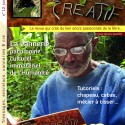Editorial: Intangible Heritage
UNESCO has classified traditional activities and artisanal crafts as parts of our Intangible Cultural Heritage (ICH). (See the introduction to the dossier on page 14.) Their intention is laudable, to protect knowledge and skills so they might be transmitted to future generations…
The job is huge! The skills required for the creation of baskets are numerous and increasingly threatened There is a very good illustration of this, in the second part of this issue of Le Lien Creatif, in the « Bulrush » dossier (page 38). Even the teachers in primary schools or even specialist courses are no longer being carried forward within a flourishing sector. Some of you reading this will probably jump up at this idea, as you yourselves are part of the current dynamic of what is our favourite pastime, but much of our knowledge is being only imperfectly transmitted. Little by little we are losing the knowhow, in its abstract sense and the manual techniques, which are developed through long practice and it is that which makes all the difference between one weaver’s creations and another’s. Some of this know-how is very specific and could be linked to a material or to a culture or both at the same time. The best recent example that I can think of, is the two layered weaves from the Mediterranean, which we find in Italy, Crete, Corsica, the Cote d’Azure and Catalunia. (See Le Lien Creatif number 11 in French only at this time). Other weaves are universal, such as mat weaving (close to cloth weaving) or cross weaving which are practiced throughout the world. There is also a remarkable diversity of variations, with the use of a wide range of materials such as wicker,
bamboo and on through to rush, grasses and pine needles. It is important to remember that if the techniques are sometimes (often!) universal, the choice of materials is opportunistic: their use depends on their presence and abundance.
If UNESCO felt the need to adopt this convention it’s not just a whim. Their representatives can see, just as we can, the different threats which exist to the transmission of knowhow. These threats are multiple and range from the spread of globalisation with the standardisation of products, to the disappearance of resources and the difficulties for the artisan to make a living from their output. Sometimes, in some communities, there is even a desire to no longer transmit knowledge from generation to generation. Artisanal crafts are seen as the past and they want to turn towards the future. We all have our part to play in making sure that this knowledge is passed on to as many people as possible. We are not the owners of this knowhow, but its safe keepers.
The UNESCO programme is ambitious and merits that, wherever we are, we pay it a lot of attention. To create specific actions which correspond to our needs and desires is a good starting point in our contribution to this dynamic. For the moment only one such project has seen the light of day in Western Europe, which is Viva basket. This project is centered in a few countries, amongst which Poland, Denmark and Norway are the principal partners.
Through the example of the Écomuseo delle erbe palustri (page 19), Luigi and Maria-Rosa show us a good example of local action and let’s hope that the new Le Lien Creatif in English will help to inspire some more.
Bernard Bertrand
Le Lien Créatif magazine, September 2015.
Tags: editorial

